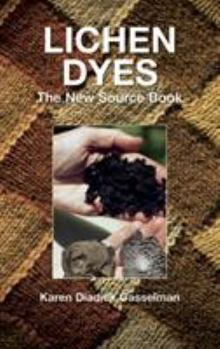Lichen Dyes: The New Source Book
Noted textile designer and lichen expert explains how to create and use dyes derived from lichens. Text covers history of the use of lichen pigments, safe dyeing methods, ecologically sound dyeing, and use of mordants, lichen identification, and more. Text also offers a fascinating history of Asian and European lichen pigments, Scottish, Irish, and Scandinavian domestic lichen dyes, and others.
Format:Paperback
Language:English
ISBN:0486412318
ISBN13:9780486412313
Release Date:November 2011
Publisher:Dover Publications
Length:96 Pages
Weight:0.30 lbs.
Dimensions:0.3" x 5.5" x 8.5"
Customer Reviews
2 ratings
Academic Abstract
Published by Thriftbooks.com User , 17 years ago
Deep and solid information, Casselman knows her lichens and seems to have devoted a lifetime to their study. That said this is a book for the trivia buff and the very serious dyer. You will learn more than you thought possible about lichens and their role in history. You will be able to dye with lichens, but you will have to have large expensive Field Guides in order to identify the lichens as in this book all you get is the Latin name. A small tome with loads of information that works witout the nasties -tin, chrome and copper
Good guide, but not for complete beginners
Published by Thriftbooks.com User , 20 years ago
This is a decent guide to dying with lichens. It is a very condensed presentation of the author's academic and practical research on the topic over many years. In terms of topics considered, the book is quite varied. It begins with a preface on ethical collecting of lichens. Next comes 10 common questions about dying with lichens covering such topics as "Will lichen dyes fade?", "How many lichens does it take to dye something?", and "How can I avoid collecting rare lichens by mistake?". Following this are short chapters on the history of lichen dyes in Asian, European, and American cultures. Then there is a very practical chapter describing in detail methods and recipes for lichen dyes, together with a list of common lichens used for dyes, grouped by dye method, and specifying final colors that can be achieved. One of the author's pet topics is ecodyeing, and she has developed techniques for dying that are less harmful to the environment than traditional methods, and she devotes a chapter to describing some of her alternatives. The last full chapter covers ethics of lichen dying and lichen identification. The book ends with a 15 page annotated bibliography. There is also an index. The only photographs in the book are the ones printed inside the front and back covers.Overall, I found this book to be clear and very well researched. I'm quite fond of lichens, but I have no background in the dyeing field. The author seems to forget how little some of her readers, such as myself, may know about natural dyes. She uses words like "mordant" without definition. Certainly, if you are already an experienced dyer, such words and their corresponding concepts will already be familiar to you. But if you are a rank beginner like myself, you might want to find another, more basic book, or seek some instruction before trying out the instructions in this one.The author works exceptionally hard in this book to convince readers that lichen collecting for making dyes is not necessarily a bad thing. Again, she overlooks the fact that some readers may come to her book completely unfamiliar with the controversy that she is trying to argue with. To make the issues more clear for the reader, it might have been useful to lay out the arguments against collecting lichens explicitly, enumerating explicitly what kinds of environmental costs may be involved. Her advice to lichen collectors sounds valid, however. She stresses above all, looking for "found" lichens, lichens that have blown off or become detached from their substrates and are lying on the ground, or collecting from sites that have been recently logged and consequently have great quantities of detached lichens on the ground. She also cautions against lichen collecting in groups, or taking more than 10% of a single lichen species from any one location. One obvious point that she makes is that you should consider your color needs carefully before you make your dye pot- -for example, there is no n





